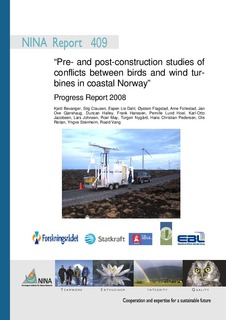"Pre- and post-construction studies of conflicts between birds and wind turbines in coastal Norway". Progress Report 2008
Bevanger, Kjetil Modolv; Clausen, Stig Morten; Dahl, Espen Lie; Flagstad, Øystein; Follestad, Arne; Gjershaug, Jan Ove; Halley, Duncan John; Hanssen, Frank Ole; Hoel, Pernille Lund; Jacobsen, Karl-Otto; Johnsen, Lars; May, Roelof Frans; Nygård, Torgeir; Pedersen, Hans-Christian; Reitan, Ole; Steinheim, Yngve; Vang, Roald
Research report

Åpne
Permanent lenke
http://hdl.handle.net/11250/2467011Utgivelsesdato
2008Metadata
Vis full innførselSamlinger
- NINA Rapport/NINA Report [2341]
- Publikasjoner fra CRIStin - NINA [2364]
Sammendrag
Bevanger, K., Clausen, S., Flagstad, Ø. Follestad, A., Gjershaug, J.O., Halley, D., Hanssen, F., Lund Hoel, P., Jacobsen, K.-O., Johnsen, L., May, R., Nygård, T., Pedersen, H.C., Reitan, O., Steinheim, Y. & Vang, R. 2008. ”Pre- and post-construction studies of conflicts between birds and wind turbines in coastal Norway”. Progress Report 2008. – NINA Report 409. 55 pp.
The NFR-funded project Pre- and post-construction studies of conflicts between birds and wind turbines in coastal Norway is about to end its second year of activities, and as such it has reached a stage of intensive fieldwork and data collection. Monitoring of bird mortality within the wind power plant area takes place on a weekly basis assisted by special trained dogs. So far in 2008 (as of December 1) 9 white-tailed sea eagles (WTSE) and 7 willow ptarmigans have been recorded. Another 4 common snipes, 2 hooded crow, 2 golden plovers, 2 greylag goose,
one grey heron, one kittiwake, one herring/greater black-backed gull, one merlin and one redshank have been collected; i.e. a total of 31 victims so far in 2008. The willow ptarmigan population have been monitored in spring and autumn and 6 willow ptarmigans were trapped and radio-tagged (in January-March). The trapping efforts have now been resumed and another 8 birds have been radio-tagged (up to December 1). A new activity on eagle owl, funded by the Directorate for Nature Management, is included in the project. The objectives with this project are, among other things, to collect mortality data using radio telemetry. However additional funding is needed. With respect to waders and smaller passerines the field work in 2008 was performed at a planned wind power plant site in Northern Norway, Andøya, to document the breeding bird status prior to the construction. The project still concentrates heavily on WTSE research, and this summer another 9 nestlings were equipped with radio transmitters, of which 3 have quit transmitting. Feather samples for DNA-analyses are collected, and when the samples of 6 WTSE adult collision victims recorded in 2008 were compared to 2006/2007 samples, it turned out that they matched two territorial birds with territories approximately 1.5 and 8 km from the wind power plant, respectively. A Master Thesis at the University of Science and Technology in Trondheim (NTNU) focusing possible effects of the wind power plant on WTSE nesting success was concluded in September. One of the conclusions was that territories within or close to the power plant had a lowered nesting success after construction, compared with the same territories before construction. Another master student has collected data on WTSE behaviour inside and outside the wind power plant area to identify possible turbine generated differences in behaviour. These data are now being processed and the Thesis will be finalized in spring 2009. An important incident this year was the procurement of a bird radar lab. After some trial and error with respect to siting within the power plant area, the radar has now been collecting data continuously since April 3. Data processing is now under way. To investigate MERLIN radar performance at its current location field trials with dedicated controlled targets have been performed using model aircraft. The MERLIN processing functions have a set of parameters which can be adjusted to each operational task and environment. The flight tests provide data which helps in optimizing these processing parameters. In connection to turbine 43 a total of 6 daylight and one IR camera have been installed to monitor bird flight behaviour close to the turbines and to learn more about how turbine generated turbulence may affect the bird’s ability to manoeuvre in the air. Another objective is to evaluate possible “early warning devices” and mitigating measures when birds get at a critical distance to a turbine. A significant effort has been put into the construction of functional operational systems for broadband transmission of data from the radar and camera systems on Smøla to NINA HQ in Trondheim. This is now in place and adequate storing and retrieving systems is being focused. Another effort is connected to developing a system for gathering all MERLIN GIS tools to be used in ArcGIS desktop 9.x. and also to develop tools for analysing collision tracks in ArcGIS desktop. An important task is the ongoing terrain modelling inside and outside the power plant area together with the ground clutter modelling and radar-coverage at different altitudes from the current MERLIN radar location. Finally we have developed a dynamic literature database (usind EndNote Web) for publications on birds and wind energy and related topics.